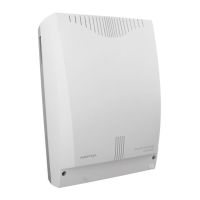Ascotel IntelliGate 2025/2045/2065
922 Operations supervision Part 7
There are several possibilities for connecting external signal destinations to a PBX:
Fig. 7.11: Overview of connection possibilities for external signal destinations
Two external signal destinations (1 preferred and 1 alternative external signal des-
tination) can be configured in the Fault & Maintenance Manager.
The PPP via ISDN communication protocol is used for the connection between the
PBX and the external signal destination.
The following parameters need to be selected or entered in the Fault & Mainte-
nance Manager for each of the two external signal destinations:
• Call number of the external signal destination (possibly as a route selection)
Possible external signal destinations include:
– Ordinary exchange output (route 3 is used)
– Route selection
– Cost centre selection (route 3)
After initialization, the call charges are allocated to cost centre 100.
• IP address of the PC if the PBX is to connect with the PC via an ISDN gateway.
If the PBX is to connect with the PC without ISDN gateway, the "IP address"
entry should remain empty.
• TCP port number (the initialization value is 1062; if the value is changed in the
SEM, it will have to be altered accordingly on the PBX side.)
• User name and password of the dial-up networking of the PC or ISDN gateway,
to gain access via the TA or the ISDN gateway to the PC with the SEM.
PBX
haz1192aaena0
TA
V.24
RTS/CTS
S
SS
T
T
T
ISDN
LAN S
ISDN
gateway
PC
COM
port
PC
ISDN
card
PC
NT1
(PBX)
NT1
(PBX)
NT1
(PBX)

